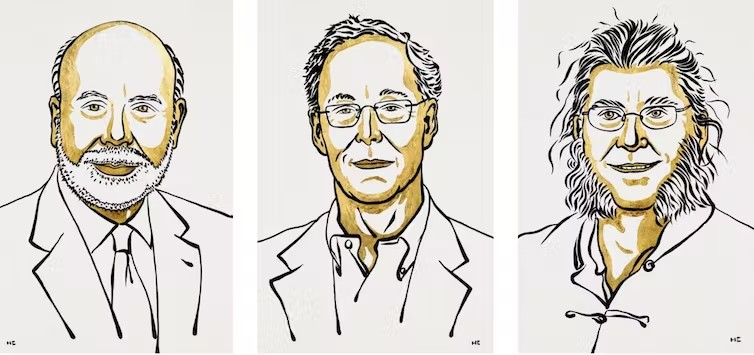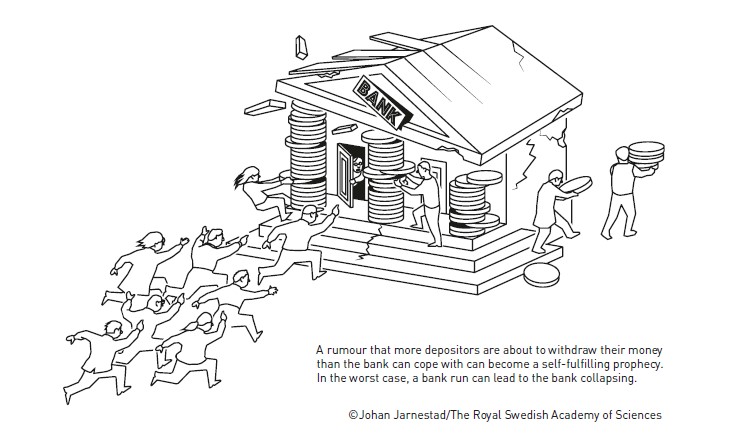What Can This Year’s Nobel Prize Winners in Economics Teach Us About Crises?

This year’s Nobel prize in economics, known as the Sveriges Riksbank Prize in Economic Sciences, has gone to Douglas Diamond, Philip Dybvig and former Federal Reserve Chair Ben Bernanke for their work on banks and how they relate to financial crises. “The laureates’ insights,” said Tore Ellingsen, chair of the Committee for the Prize in Economic Sciences, “have improved our ability to avoid both serious crises and expensive bailouts.”
To explain the work and why it matters, we talked to Elena Carletti, a Professor of Finance at Bocconi University in Milan.
Why have Diamond, Bernanke and Dybvig been awarded the prize?
The works by Diamond and Dybvig essentially explained why banks exist and the role they play in the economy by channeling savings from individuals into productive investments. Essentially, banks play two roles. On the one hand, they monitor borrowers within the economy. On the other, they provide liquidity to individuals, who don’t know what they will need to buy in future, and this can make them averse to depositing money in case it’s not available when they need it. Banks smooth out this aversion by providing us with the assurance that we will be able to take out our money when it’s required.
The problem is that by providing this assurance, banks are also vulnerable to crises even at times when their finances are healthy. This occurs when individual depositors worry that many other depositors are removing their money from the bank. This then gives them an incentive to remove money themselves, which can lead to a panic that causes a bank run.

Ben Bernanke fed into this by looking at bank behavior during the great depression of the 1930s, and showed that bank runs during the depression was the decisive factor in making the crisis longer and deeper than it otherwise would have been.
The observations behind the Nobel win seem fairly straightforward compared to previous years. Why are they so important?
It’s the idea that banks that are otherwise financially sound can nevertheless be vulnerable because of panicking depositors. Or, in cases such as during the global financial crisis of 2007-09, it can be a combination of the two, where there is a problem with a bank’s fundamentals but it is exacerbated by panic.
Having recognized the intrinsic vulnerability of healthy banks, it was then possible to start thinking about policies to alleviate that risk, such as depositor insurance and reassuring everyone that the central bank will step in as the lender of last resort.
In a bank run caused by liquidity (panic) rather than insolvency, an announcement from the government or central bank is likely to be enough to solve the problem on its own – often without the need for any deposit insurance even being paid out. On the other hand, in a banking crisis caused by insolvency, that’s when you need to pump in money to rescue the institution.
What was the consensus about bank runs before Diamond and Dybvig began publishing their work?
There had been a lot of bank runs in the past and it was understood that financial crises were linked to them – particularly before the US Federal Reserve was founded in 1913. It was understood that bank runs made financial crises longer by exacerbating them. But the mechanism causing the bank runs wasn’t well understood.

How easy is it to tell what kind of bank run you are dealing with?
It’s not always easy. For example, 2008 in Ireland was thought to be a classic example of bank runs caused by liquidity fears. The state stepped up to give a blanket guarantee to creditors, but it then became apparent that the banks were really insolvent and the government had to inject enormous amounts of money into them, which led to a sovereign debt crisis.
Speaking of sovereign debt crises, the work by Diamond and Dybvig also underpins the literature on financial contagion, which is based on a 2000 paper by Franklin Allen and Douglas Gale. I worked with Allen and Gale for many years, and all our papers have been based on the work of Diamond, and Diamond and Dybvig.
In a similar way to how state reassurances can defuse a bank run caused by liquidity problems, we saw how the then European Central Bank President Mario Draghi was able to defuse the run on government bonds in the eurozone crisis in 2011 by saying that the bank would do “whatever it takes” to preserve the euro.
The prize announcement has attracted plenty of people on social media saying we shouldn’t be celebrating Bernanke when he was so involved in the quantitative easing (QE) that has helped to cause today’s global financial problems – what’s your view?
I would say that without QE our problems would today be much worse, but also that the prize recognizes his achievements as an academic and not as chair of the Fed. Also, Bernanke was only one of the numerous central bankers who resorted to QE after 2008.
And it is not only the central bank actions that make banks stable. It’s also worth pointing out that the changes to the rules around the amount of capital that banks have to hold after 2008 have made the financial system much better protected against bank runs than it was beforehand.
Should such rules have been introduced when the academics first explained the risks around bank runs and contagion?
The literature had certainly hinted at these risks, but regulation-wise, we had to wait until after the global financial crisis to see reforms such as macro-prudential regulation and more stringent micro-prudential regulation. This shows that regulators were underestimating the risk of financial crises, perhaps also pushed by the banking lobbies that had been traditionally very powerful and managed to convince regulators that risks were well managed.
If retail banks become less important in future because of blockchain technology or central bank digital currencies, do you think the threat of financial panic will reduce?
If we are heading for a situation where depositors put their money into central banks rather than retail banks, that would diminish the role of retail banking, but I think we are far from that. Central bank digital currencies can be designed in such a way that retail banks are still necessary. But either way, the insights from Diamond and Dybvig about liquidity panics are still relevant because they apply to any context where coordination failures among investors are important, such as sovereign debt crises, currency attacks and so on.


























































































